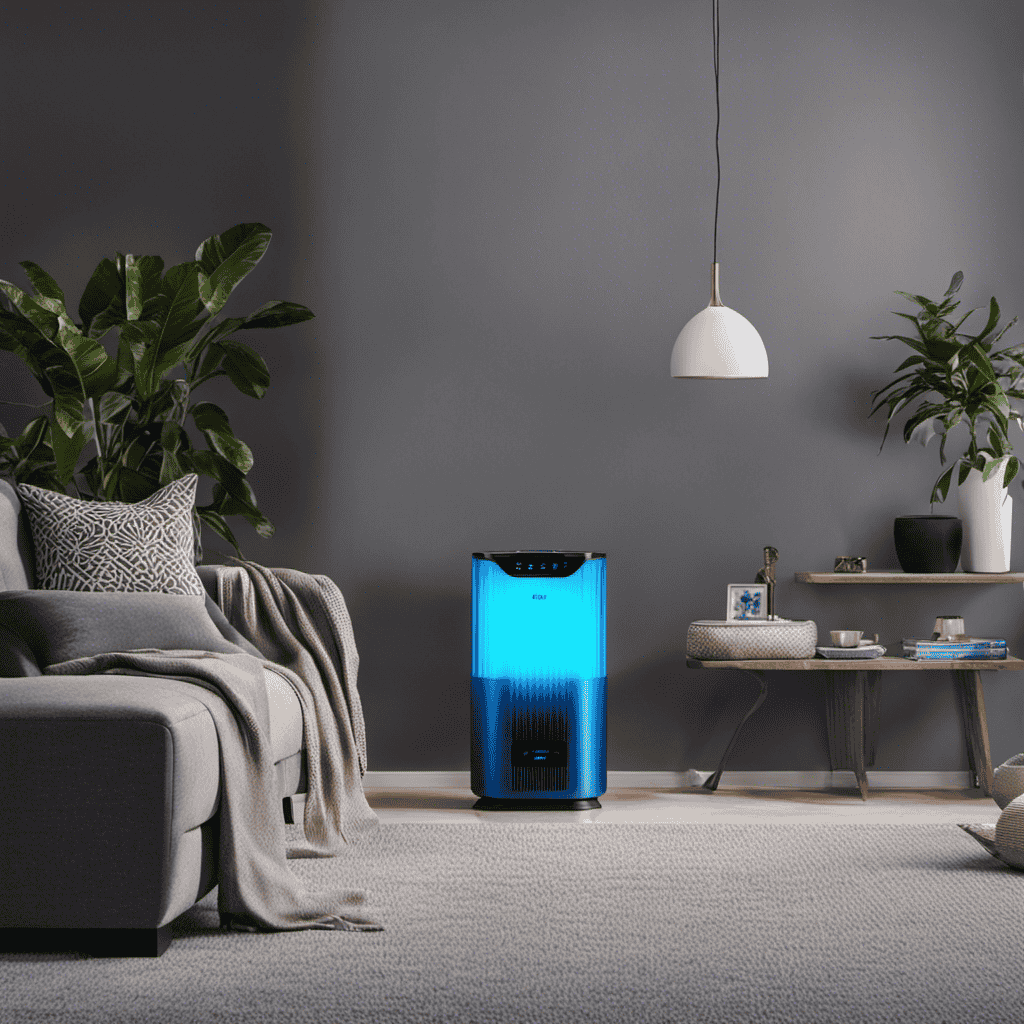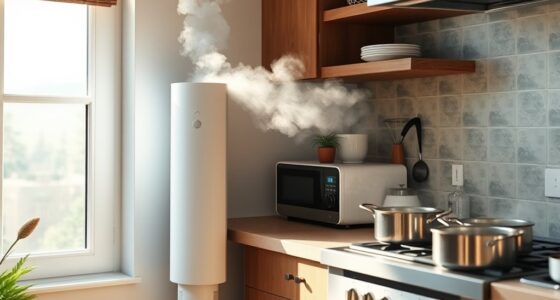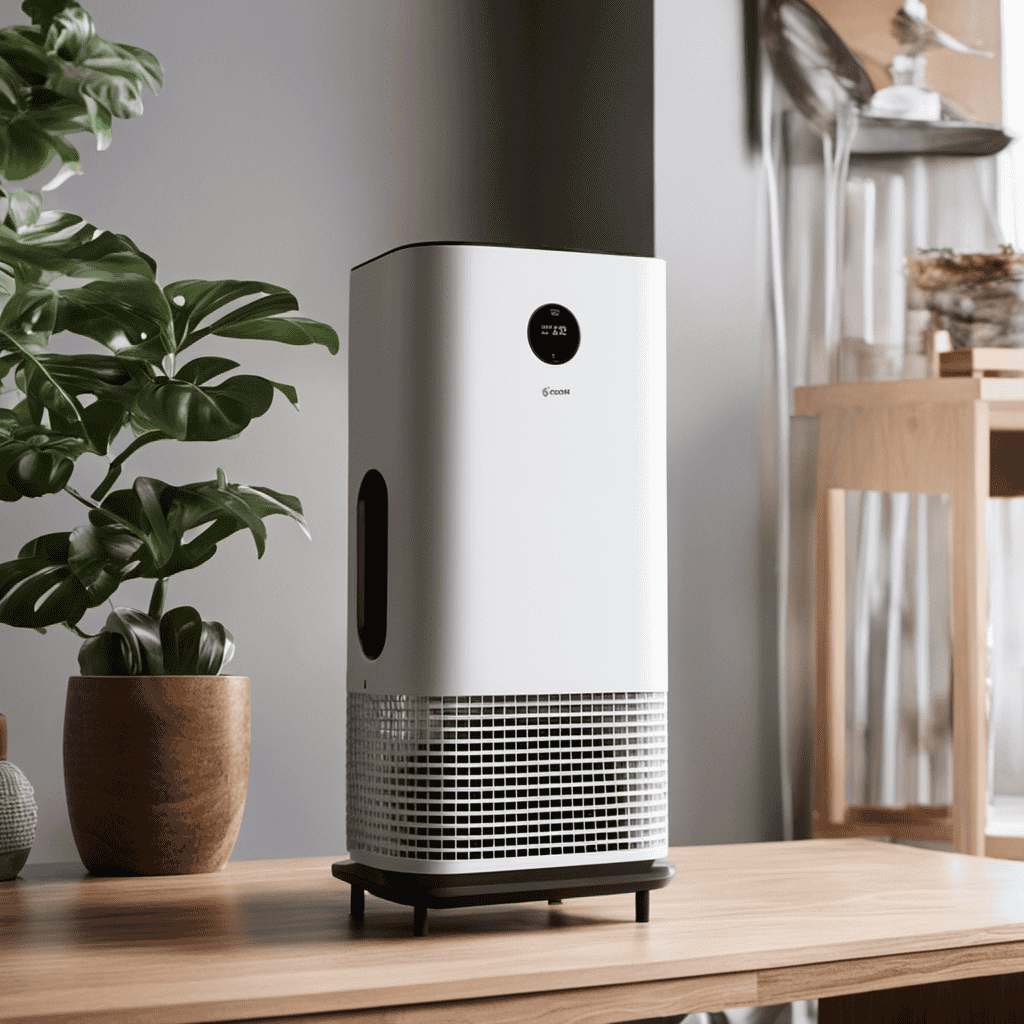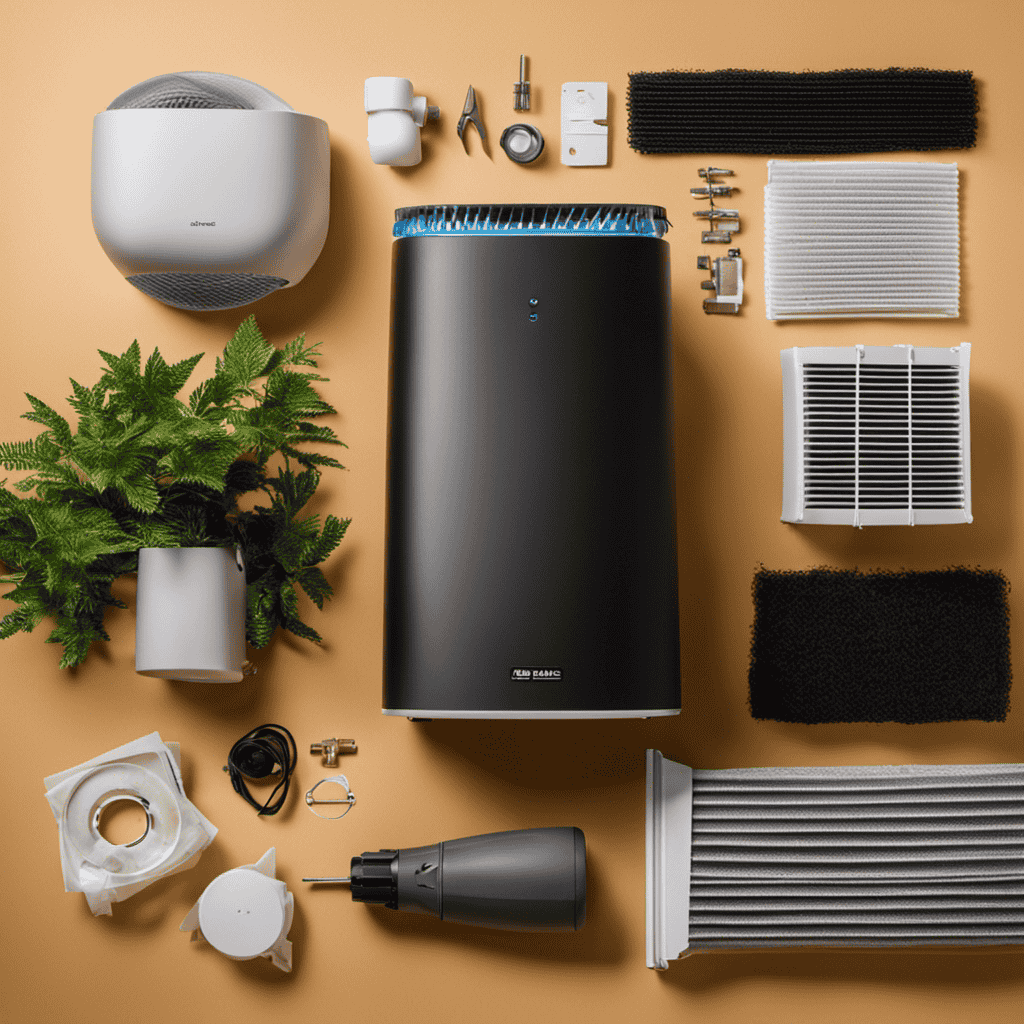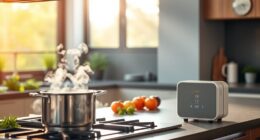As a homeowner who cares about the air quality in my home, I often wonder about the effectiveness of my air purifier. Is it actually cleaning the air like it’s supposed to? Like a reliable protector, an air purifier should efficiently eliminate pollutants and allergens, providing clean and fresh air for me to breathe.
In this article, we will delve into the inner workings of air purifiers, evaluating their functionality, monitoring their performance, and assessing their filter effectiveness. Let’s unravel the mystery and discover how to confidently answer the question, ‘Is my air purifier truly working?’
Key Takeaways
- Air purifiers use a combination of filters to remove pollutants and allergens from indoor air.
- Measuring air pollutant levels and comparing them before and after using an air purifier helps evaluate its effectiveness.
- Tracking respiratory symptoms and conducting lung function tests can assess the impact of cleaner air on respiratory health.
- Monitoring air quality indicators, noise levels, and energy consumption helps determine the performance and effectiveness of an air purifier.
Understanding Air Purifier Functionality
To understand if your air purifier is working, you can look for signs such as cleaner air, reduced odors, and less dust in your home.
Air purifier technology is designed to improve indoor air quality by removing pollutants and allergens from the air. The filtration process is a key component of this technology. Most air purifiers use a combination of filters, including a pre-filter, a HEPA filter, and an activated carbon filter.
The pre-filter captures larger particles like dust and pet hair, while the HEPA filter traps smaller particles such as pollen, mold spores, and pet dander. The activated carbon filter helps reduce odors by absorbing gases and chemicals.
Evaluating Air Quality Improvement
When it comes to evaluating air quality improvement, there are a few key points to consider.
First, measuring air pollutant levels is crucial in determining the effectiveness of any air purification system. This involves using specialized equipment to quantify the concentration of pollutants in the air.
Second, assessing breathing improvements is essential in understanding the impact of cleaner air on our respiratory health. This can be done through various methods such as lung function tests and subjective evaluations of symptoms.
Lastly, comparing the air quality before and after using an air purifier provides valuable insights into the effectiveness of the device in reducing pollutant levels and improving overall air quality.
Measuring Air Pollutant Levels
You can measure air pollutant levels by using an air quality monitor. These devices are designed to detect and quantify various pollutants in the air, such as particulate matter (PM2.5 and PM10), volatile organic compounds (VOCs), carbon dioxide (CO2), and ozone (O3). By regularly monitoring the air quality in your environment, you can evaluate the effectiveness of your air purifier in reducing these pollutants.
To track air pollutant reduction, you can create a table to record the initial pollutant levels before using the air purifier and compare them with the levels after using the purifier for a certain period of time. This will provide you with tangible data to assess the purifier’s performance. Here is an example of a table:
| Pollutant | Initial Level (Before) | Level After 1 Month | Level After 3 Months |
|---|---|---|---|
| PM2.5 | 25 µg/m³ | 10 µg/m³ | 5 µg/m³ |
| VOCs | 100 ppb | 50 ppb | 20 ppb |
| CO2 | 800 ppm | 500 ppm | 400 ppm |
| O3 | 50 ppb | 30 ppb | 20 ppb |
Assessing Breathing Improvements
Assessing breathing improvements can be done by monitoring changes in respiratory symptoms and lung function over time.
When evaluating the health benefits of an air purifier, it is important to track respiratory symptoms such as coughing, wheezing, and shortness of breath. These symptoms can be assessed using self-reported questionnaires or diaries, where individuals record the frequency and severity of their symptoms.
Additionally, lung function tests, such as spirometry, can provide objective measurements of respiratory function. These tests measure parameters like the amount of air one can forcefully exhale in one second (FEV1) and the total amount of air exhaled (FVC).
Comparing Before and After
Once you compare your respiratory symptoms and lung function before and after using an air purifier, you will be able to determine if there has been an improvement in your breathing quality and overall respiratory health.
To evaluate the effectiveness of the air purifier, follow these steps:
- Record your respiratory symptoms before using the air purifier, such as coughing, wheezing, or shortness of breath.
- Measure your lung function using a peak flow meter or spirometer before using the air purifier.
- Use the air purifier consistently for a significant period of time, at least a few weeks.
- Repeat the measurement of your respiratory symptoms and lung function after using the air purifier for the specified time period.
By comparing the results before and after using the air purifier, you can determine if there has been an improvement in your breathing quality and overall respiratory health. This evaluation will help you make an informed decision about the effectiveness of the air purifier in improving your indoor air quality.
Transitioning into the subsequent section about monitoring air purifier performance, it is important to regularly assess the air purifier’s performance to ensure its continued effectiveness.
Monitoring Air Purifier Performance
To determine if an air purifier is working effectively, simply check the air quality indicators on the device. These indicators provide real-time information about the current air quality in your environment.
Additionally, monitoring air purifier noise levels can also give you an idea of its performance. A properly functioning air purifier should operate quietly, with minimal noise disturbance.
Another aspect to consider is tracking air purifier energy consumption. Energy-efficient models are not only more cost-effective but also more environmentally friendly. By monitoring the energy usage of your air purifier, you can ensure that it is working efficiently and not consuming excessive power.
These factors, including air quality indicators, noise levels, and energy consumption, play a crucial role in determining the effectiveness of an air purifier in improving indoor air quality.
Now, let’s move on to testing air purifier efficiency.
Testing Air Purifier Efficiency
When it comes to assessing air quality, reliable air quality tests are essential. These tests provide crucial information on the presence and concentration of pollutants in the air, allowing us to evaluate the cleanliness of the environment.
Measuring clean air requires accurate and precise instruments that can detect a wide range of pollutants, ensuring a comprehensive analysis of the air quality.
Reliable Air Quality Tests
If you’re wondering how to determine if an air purifier is working, reliable air quality tests can provide you with accurate results. These tests are crucial for air quality monitoring and can help you assess the effectiveness of your air purifier. Here are four key factors to consider when conducting air quality tests:
-
Airborne particle count: A reliable test should measure the concentration of particles in the air, including dust, pollen, and pet dander. This will give you a clear indication of how well the air purifier is filtering out these pollutants.
-
VOC levels: Volatile organic compounds (VOCs) are harmful chemicals found in many household products. A good air quality test will measure the levels of VOCs in the air, allowing you to evaluate the purifier’s ability to remove them.
-
Carbon dioxide levels: Monitoring carbon dioxide levels is important for assessing indoor air quality. A functioning air purifier should help maintain low CO2 levels, providing a healthier environment.
-
Air purifier certification: Look for air purifiers that are certified by reputable organizations such as the Association of Home Appliance Manufacturers (AHAM) or the National Sanitation Foundation (NSF). These certifications ensure that the purifier meets certain standards of effectiveness.
Measuring Clean Air
After conducting reliable air quality tests, the next step is to continuously monitor the air quality to determine the effectiveness of an air purifier.
Monitoring air quality involves the measurement and analysis of various pollutants present in the air, such as particulate matter, volatile organic compounds (VOCs), and carbon dioxide (CO2) levels. This can be done using specialized air quality monitors that provide real-time data on pollutant levels.
By comparing the air quality measurements before and after using an air purifier, one can assess its effectiveness in reducing pollutants. Additionally, monitoring air quality helps identify any potential sources of pollution, allowing for targeted efforts to improve indoor air quality.
Regular monitoring is crucial to ensure a healthy and clean environment, and to make informed decisions regarding the maintenance and replacement of air purifiers.
Assessing Air Purifier Filter Effectiveness
To determine if an air purifier is working, check the filter for any signs of dirt or debris. Evaluating filter performance is crucial in maintaining the efficiency of an air purifier.
Here are four key factors to consider when assessing air purifier filter effectiveness:
-
Visual Inspection: Examine the filter for visible dirt, dust, or pet dander. A clogged or dirty filter indicates a higher level of filtration activity.
-
Airflow Analysis: Assess the air purifier’s airflow. Restricted or weak airflow may indicate a blocked or saturated filter.
-
Odor Reduction: A functioning air purifier should effectively eliminate unpleasant odors. If persistent odors remain, it may be time to replace the filter.
-
Filter Lifespan: Refer to the manufacturer’s guidelines to determine the recommended filter lifespan. Regularly replacing filters is essential to maintain optimal air purification.
By evaluating these factors, you can ensure that your air purifier is effectively filtering the air.
Now, let’s move on to verifying air purifier maintenance requirements.
Verifying Air Purifier Maintenance Requirements
To verify the maintenance requirements of your air purifier, check the user manual for specific guidelines on cleaning and filter replacement.
Proper maintenance is crucial for ensuring the optimal performance of your air purifier.
When it comes to filter replacement, it is important to follow the manufacturer’s recommendations. Most air purifiers have indicators that notify you when the filters need to be changed. These indicators are typically based on the number of operating hours or the level of particulate matter in the air.
Additionally, it is essential to regularly check the functionality of the fan. The fan plays a vital role in the circulation of air and the effectiveness of the purifier. If you notice any unusual noises, reduced airflow, or a complete lack of airflow, it may indicate a problem with the fan that requires attention.
Regular maintenance and periodic verification are key to ensuring that your air purifier is working efficiently.
Frequently Asked Questions
How Much Noise Does an Air Purifier Make?
When choosing the right air purifier, it is important to consider the noise level. The noise produced by an air purifier can vary depending on the model and settings, so it’s essential to check the specifications before purchasing. Regular air purifier maintenance can also help in reducing noise levels.
Can an Air Purifier Remove Pet Dander?
To determine the effectiveness of an air purifier, maintenance is key. Regularly clean or replace filters and monitor the device for any signs of malfunction. By following these steps, you can ensure that your air purifier is removing pet dander and improving indoor air quality.
Will an Air Purifier Eliminate Cooking Odors?
An air purifier can effectively eliminate cooking odors by capturing and neutralizing the airborne particles responsible for the smell. By continuously circulating and filtering the air, the purifier ensures a fresh and odor-free environment.
Can an Air Purifier Kill Bacteria and Viruses?
An air purifier can kill bacteria and viruses, increasing indoor air quality and reducing the risk of illness. Studies show that air purifiers with HEPA filters can capture up to 99.97% of airborne particles, including harmful microorganisms.
Is It Safe to Leave an Air Purifier on All Night?
It is safe to leave an air purifier on all night, as long as proper maintenance is performed regularly. Using an air purifier offers numerous benefits, such as removing airborne pollutants and improving indoor air quality.
Conclusion
In conclusion, determining if an air purifier is working involves understanding its functionality and evaluating air quality improvement. Monitoring performance, testing efficiency, and assessing filter effectiveness are also crucial steps. By following these steps, you can ensure that your air purifier is effectively removing pollutants and improving indoor air quality.
Don’t underestimate the importance of regular maintenance to keep your air purifier running smoothly. Remember, a well-functioning air purifier is like a superhero for your lungs. It fights off invisible villains and creates a healthier environment for you to breathe in.

